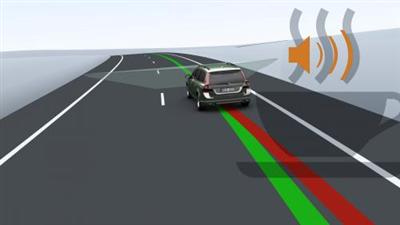|
| ||||
|
Volvo to introduce new systems for alerting tired drivers
25th August, 2008 | |||
|
Volvo's Driver Alert Control and Lane Departure Warning system, which alerts the driver if the vehicle unintentionally moves outside lane markings, will be available in the Volvo S80, V70, XC70 and XC60 when it is launched next year. "Real-life safety is the key to our safety philosophy. When it comes to preventive safety, we have the same approach as when we develop protective systems. In other words, that our research and technical development focus on areas where new technology can create significant results in real-life traffic," says Jan Ivarsson, Senior Manager Safety Strategy & Requirements. With studies showing up to 90 per cent of all accidents are a result of driver distraction, Volvo Cars is focusing on developing efficient technology to help drivers avoid or reduce the severity of accidents caused by distraction and driver fatigue. Driver Alert Control (DAC) As a result of extensive studies on how drivers operate behind the wheel, Volvo has developed Driver Alert Control - which tracks a vehicles movement between lane markings and alerts inattentive drivers when required. Driver fatigue is a major traffic-safety issue the world over. According to the National Highway Traffic Safety Administration (NHTSA), drivers who fall asleep at the wheel cause about 100,000 accidents annually in the United States alone, resulting in 1,500 fatalities and more than 70,000 injured drivers and passengers. The situation is similar in Europe. The German Insurance Association (GDV) estimates that about 25 percent of all fatal accidents on the German Autobahn are caused by driver fatigue. Volvo's Driver Alert Control, which is active from 65 km/h, is primarily intended for situations where the risk of losing concentration is the greatest and where an accident would have severe consequences. For example a straight, smooth highway that lulls the driver into a sense of relaxation and where the risk of distracting activities or falling asleep is higher. DAC registers driving behaviour not human behaviour Driver Alert Control monitors the car's movements and assesses whether the vehicle is being driven in a controlled manner using a reliable method unique to Volvo. "We do not monitor human behaviour - which varies from one person to another - but instead the effect that fatigue or decreased concentration has on driving behaviour. Our technology is based on the car's progress on the road. It gives a reliable indication if something is likely to go wrong and alerts the driver before it is too late," explains Daniel Levin, project manager for Driver Alert Control at Volvo Cars. "We often get questions about why we have chosen this concept instead of monitoring the driver's eyes. The answer is that we don't think that the technology for monitoring the driver's eyes is mature enough yet," Mr Levin added. In addition, Driver Alert Control can also cover situations where the driver is distracted by other passengers or external factors thereby not having full control of the vehicle. "This is a positive side-effect of our concept and this is possible since the feature evaluates driving behaviour rather than human behaviour," says Mr Levin. DAC – audible signal and visual messages warn drivers Driver Alert Control consists of a camera, a number of sensors and a control unit. The camera, which is installed between the windscreen and the interior rear-view mirror, continuously measures the distance between the car and the road lane markings. The sensors register the car's movements, while the control unit stores the information and calculates whether the driver risks losing control of the vehicle. If the risk is assessed as high, the driver is alerted via an audible signal. In addition, a text message appears in the car's information display, alerting him or her with a coffee cup symbol and a message to 'take a break'. What's more, the driver can continuously monitor their own driving style via the vehicle's information display. The starting-point is five bars - the less consistent the driving, the fewer bars remain. "It is, of course, always the driver's responsibility to take a break when necessary, but sometimes you might not realise that you're not alert enough to drive. In such situations, Driver Alert Control can help the driver make the right decision, like taking a refreshing break or a nap, before the concentration level becomes too low," Mr Levin concludes. Lane Departure Warning (LDW) On US highways, single-vehicle road departures account for approximately one fourth of all accidents and one third of all fatalities. Such statistics emphasise the risks associated with losing concentration in smooth driving conditions. To address the issue, Volvo Cars has introduced its Lane Departure Warning system. It helps prevent single-vehicle road departure accidents as well as head-on collisions due to temporary distraction. Volvo Cars' researchers estimate that the LDW function can help prevent 30 to 40 percent of these types of accidents at speeds between 70 km/h and 100 km/h. LDW is activated via a button in the centre stack and it alerts the driver with a gentle warning sound if the car crosses one of the road markings without indicating. The function also uses a camera to monitor the car's position between the road markings. LDW steps in at 65 km/h and stays active as long as the speed exceeds 60 km/h. Certain limitations The functionality depends on the visibility and quality of the road markings. The lane markings must be clearly visible to the camera. Poor light, fog, snow and extreme weather conditions can make the feature unavailable. | ||||
ABN 47106248033 |
 |
All rights reserved. |


 Volvo Car Australia will introduce 'Driver Alert Control', a system that seeks to alert the
driver to lapses in concentration, along with its 'Lane Departure Warning' system from October 2008 as part of its 2009
model line-up.
Volvo Car Australia will introduce 'Driver Alert Control', a system that seeks to alert the
driver to lapses in concentration, along with its 'Lane Departure Warning' system from October 2008 as part of its 2009
model line-up.